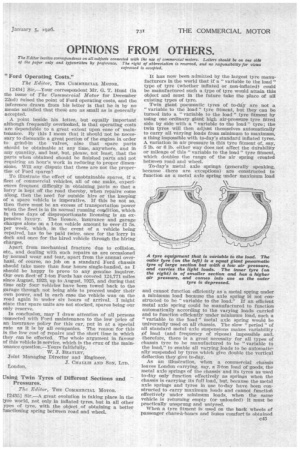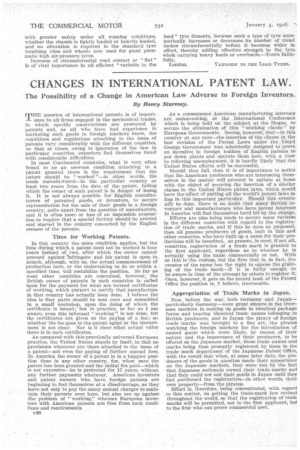OPINIONS FROM OTHERS.
Page 29

Page 30

If you've noticed an error in this article please click here to report it so we can fix it.
The Editor invites correspondence on all subjects connected with ilw use of commercial motors. Letters should be on one side of the paper old), and typewritten by preference. The right of abbreviation is reserved, and no responsibility for views
expressed is accepted.
"Ford Operating Costs."
The Editor, THE COMMERCIAL MoToa, [2434] Sir,—Your correspondent Mr. G. T. Hunt (in the issue of The Commercial Motor for December 22nd) raised the point of Ford operating costs, and the inference drawn from his letter is that he Is by no means satisfied that these are as small as is generally accepted.
A point beside his letter, but equally important although frequently overlooked, is that operating costs are dependable to a great extent upon ease of maintenance. By this I mean that it should not be necessary to dismantle a great portion of the engine in order to grind-in the valves, also that spare parts should be obtainable at any time, anywhere, and in any quantity, and last, but, please, not least, that the parts when obtained should be finished parts and not requiring an hour's work in reducing to proper dimensions. Will any dispute that these are not the properties of Ford spares?
To illustrate the effect of unobtainable spares, if a fleet of commercial vehicles, all of one make, experiences frequent difficulty in obtaining parts so that a lorry' is kept off the road thereby, when repairs come along, then the need for outside hire or the keeping of a spare vehicle is imperative. If this be not so, then there must be an excess of transportation power when the fleet is in its normal running cowlition, which in these days of disproportionate licensing is an expensive luxury. The licence, insurance and garage charges alone on a 1-ton vehicle amount to over Xi 5s. per week, which, in the event of a vehicle being repaired, has to be paid twice, once for the lorry In dock and once for the hired vehicle through the hiring charges.
Apart from mechanical fracture due to collision, etc., and dealing with such repairs as are occasioned by normal wear and tear, apart from the annual overhaul, of course, no job on a standard Ford chassis should take more than four hours single-handed, as I should be happy to prove to any genuine inquirer. Our own fleetof 1-ton Fords has covered 124,771 miles since August, 1923, up to August, 1925, and during that time only four vehicles have been towed back to the garage through not being able to proceed under their own power, and in each case the vehicle was on the road again in under six hours of arrival. I might state that spare units are not stocked, spares being our only reserve.
In conclusion, may I draw attention of all persons !onnected with Ford maintenance to the low price of an insurance policy for this car, put in at a special rate as it is by all companies. The reason for this is the low cost of repairs and the short time in which they Can be effected. The whole argument in favour of this vehicle is service, which is the crux Of the main%mince question.—Yours faithfully, W. J. BEATLEY,
Joint Managing Director and Engineer,
J. CHALLIS AND SON, LTD. London.
Using Twin Tyres of Different Sections and Pressures.
The Editor, THE COMMERCIAL MOTOR.
[2435] Sir,—A great evolution is taking place in the tyre world, not only in inflated tyres, but in all other ypes of tyre, with the object of obtaining a better tunctioning spring between road and wheel.
It has now been admitted by the largest tyre manufacturers in the world that if a variable to the load" type of tyre (whether inflated or non-inflated) could be manufactured such a type of tyre would attain this object and must in the future take the place of all existing types of tyre.
Twin giant pneumatic tyres of to-day are not a "variable to the load" tyre fitment, but they can be turned into a "variable to the load" tyre fitment by using one ordinary giant high air-pressure tyre fitted side by side with a "variable to the load" tyre; the twin tyres will then adjust themselves automatically to carry all varying loads from minimum to maximum, a thing impossible with to-day's standard inflated tyres. A variation in air pressure in this tyre fitment of, say, 5 lb. or 6 lb. either way does not affect the durability or mileage of this "variable to the load " tyre fitment, which doubles the range of the air spring created between road and wheel.
To-day's metal axle springS (generally speaking, because there are exceptions) are constructed to function as a metal axle spring under maximum load and cannot function efficiently as a metal spring under a minimum load because the axle spring is not constructed to be "variable to the load." If an efficient metal axle spring could be manufactured to function automatically according to the varying loads carried and to function efficiently under minimum load, such a "variable to the toad" metal axle spring would be universally used on all chassis. The slow " period " of all standard metal axle suspensions makes variability. !of load (and frequency of repose) impossible and, therefore, there is a great necessity for all types of chassis tyre to be manufactured to be "variable to the load," to enable all varying loads to be automatically suspended by tyres which give double the vertical deflection they give to-day.
As an illustration, when a commercial chassis leaves London carrying, say, a 3-ton load of goods, the metal axle springs of the chassis and its tyres as used to-day only function effectively as springs when the chassis is carrying its full load, but, because the metal axle springs and tyres in use to-day have been constructed to carry maximum loads and cannot functiofi effectively under minimum loads, when the same vehicle is returning empty (or unloaded) it must be practically unsprung and untyred.
When a tyre fitment is used on the back wheels of passenger chars-ii-bancs and huSes comfort is obtained c45 with greater safety under all running conditions, whether the chassis is lightly loaded or heavily loaded, and no alteration is required in the standard tyre retaining rims and wheels now used for giant pneumatic high air-pressure tyres.
Increase of circumferential road contact or " flat " is of vital importance in all efficient "variable to the load" tyre fitments, because such a type of tyre automatically increases or decreases its number of tread inches circumferentially before it • becomes wider in effect, thereby adding effective strength to the tyre wheh carrying heavy loads or overloads.—Yours faithfully, London. VARIABLE TO THE LOAD TYRES.
































